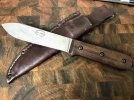- Joined
- Aug 24, 2006
- Messages
- 827
No, I didn't baton a bunch of wood or drill a bunch of holes. But I did wear it all weekend long as I went out to do some shooting on some BLM land. It rode behind my pistol all weekend and suffered the wear that goes with it, getting a few dings in the sheath and wearing through the threads. It prepped a bunch of food, cut some cord here and there, and all in all was a nice useful knife.
Turns out the thread used in the sheath may not be the most abrasion resistant known to man. No matter, the holes in for the stitching are big enough that (with the help of an awl and a couple of saddlers needles) I was able to saddle stitch it (double actually) all back together. I'm glad there are rivets!
At the end of the day the knife is useful, works well, the sheath holds the knife just fine, and I think this new thread will be a bit tougher. It's a nice knife, though I think I'd love to have one with a ~4 inch blade.
Sheath all fixed up. Apparently I went over when I should have gone under on one of those stitches, ah well, at least it's functional!

Turns out the thread used in the sheath may not be the most abrasion resistant known to man. No matter, the holes in for the stitching are big enough that (with the help of an awl and a couple of saddlers needles) I was able to saddle stitch it (double actually) all back together. I'm glad there are rivets!
At the end of the day the knife is useful, works well, the sheath holds the knife just fine, and I think this new thread will be a bit tougher. It's a nice knife, though I think I'd love to have one with a ~4 inch blade.
Sheath all fixed up. Apparently I went over when I should have gone under on one of those stitches, ah well, at least it's functional!


